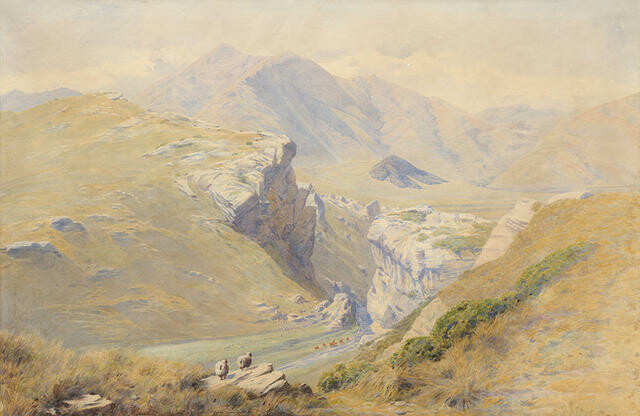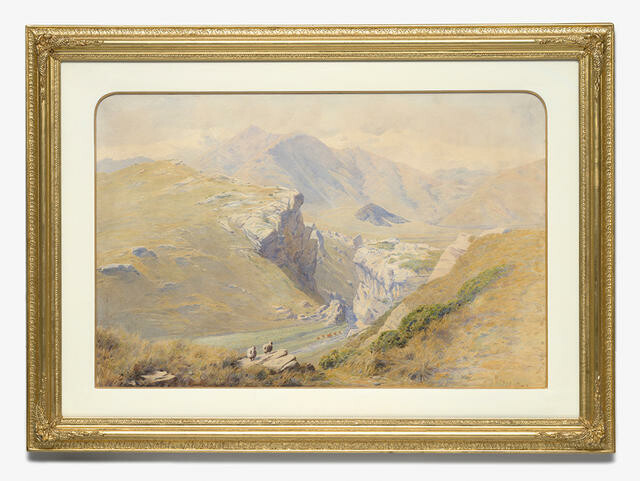James Crowe Richmond
Aotearoa New Zealand / British, b.1822, d.1898
Mount Torlesse from near Castle Hill, West Coast Road, Limestone Gate on the Thomas River
- 1872
- Watercolour
- Purchased, 2003
- 940 x 1290 x 50mm
- 2003/04
- View on google maps
Location: Sir Robertson and Lady Stewart Gallery
Tags: animals, cows (mammals), landscapes (representations), mountains, natural landscapes, rivers, sheep
The Kura Tawhiti Castle Hill area was an ancient moa habitat and hunting ground for Waitaha people and later a trading and seasonal kūmara gardening site for Kāti Māmoe and Kāi Tahu. Oral histories from the Waitaha period recalls a giant pouākai nest here from which a terrifying marauding bird was lured to its death by the visiting warrior Te Hau-o-Tawera, to be set upon by fifty men armed with spears. The mountain on which the bird nested was named Tawera, after him, but later renamed after Canterbury Association surveyor Charles Torlesse, who climbed it in 1849. Watercolourist James Richmond was also the former Minister of Native Affairs and Commissioner of Crown Lands, and was committed in both his political career nd personal endeavours to expanding settler territory and suppressing Māori resistance to European land acquisition.
moa ~ large extinct flightless bird
kūmara ~ sweet potato
Waitaha ~ tribal group that occupied much of Te Waipounamu South Island before they were displaced by Kāti Māmoe
Kāti Māmoe ~ tribal group that was largely replaced by Kāi Tahu through intermarriage and conquest
Kāi Tahu ~ tribal group of much of Te Waipounamu South Island
pouākai ~ giant, extinct eagle, later also known as Haast’s eagle
He Kapuka Oneone – A Handful of Soil (from August 2024)
Exhibition History
Castle Hill rises above the rocky limestone outcrops of the surrounding countryside in the Southern Alps of New Zealand. ‘Middle Earth’ country, for followers of Lord of the Rings. A sheep station was established here in the 1860s and in the days of coach travel between Canterbury and the West Coast a large accommodation house was established, built of the local limestone.
A gifted amateur, James Richmond brought to his skills as a watercolourist his engineering accuracy and attention to detail. This landscape would have been completed in the studio from sketches he made in the open. The scale of this work displays Richmond’s confidence with watercolour.
Born in London, Richmond trained as a civil engineer. He moved to New Zealand in 1850. To escape the Land Wars in Taranaki, in 1862 Richmond shifted to Nelson where he became Commissioner of Crown Lands. Later he became an important figure in the Cabinet and Minister of Native Affairs.
(Label date unknown)


